By Keith Sampson, Senior Vice President, Energy Services and Chris Brook, Director of Natural Gas & Energy Services
Like most of us who are watching energy market price fluctuations, you may be asking questions such as “Why have natural gas prices increased so much?” “When will they go down?” “What will cause prices to decrease?” "Are high prices here to stay?” You are also likely wondering what the future holds – for your business and your household.
Two of CES’ energy experts and influencers Keith Sampson, Senior Vice President, Energy Services, and Chris Brook, Director of Natural Gas & Energy Services decided to talk through current market trends and commodity price fluctuations and share information on New England natural gas commodity costs – in the hope of answering some of your questions. Below are excerpts from their discussion:
CHRIS: Today we are going to have a conversation about current natural gas fundamentals and their impact on New England. As we sit down to chat, futures prices have more than doubled for this coming winter. What is causing the alarming jump in commodity prices that we have seen in the past few months?
KEITH: There are a number of different factors, and we should start with the basics: Economics 101. The law of supply and demand without question drives the energy markets. Price increases are then driven by concerns over a world-wide scarcity of natural gas. Below average storage levels resulting from increased demand and lower output have energy markets concerned as we head into the winter heating season in North America, Europe, and Asia. To break this down even further, we want to look at two components: commodity and BASIS.
Natural gas is a commodity that is traded on the New York Mercantile Exchange (NYMEX). In the United States, we use the Henry Hub as the pricing point. Natural gas also trades on similar exchanges in foreign markets. As markets become more connected due to exports, natural gas prices have made the transition from regional markets to world-wide markets similar to how oil markets have been connected for decades.
In addition to the increases in NYMEX, New England BASIS futures have skyrocketed in recent months. BASIS is the cost to reserve space in the interstate pipeline network to transport gas from the point of production to the local distribution gate station. BASIS tends to be much more regionally focused and is impacted by interstate pipeline infrastructure. BASIS is a cost in addition to the local distribution company costs.
In addition to being used for heating and industrial processing, cost of gas is highly correlated to the cost of electricity. With increases in both NYMEX and BASIS futures, electricity futures have also climbed since the pandemic started in Q1 of 2020.
CHRIS: What are the underlying factors involved in these price increases?
KEITH: First, supply. Production of natural gas has not rebounded to the same levels as before the pandemic. Suppliers are more disciplined, and less money is flowing into production. That fact, combined with the effects of Hurricane Ida, have had a major influence on markets and prices. The high winds from Ida initially impacted 80 percent of the Gulf Coast’s oil and gas production capacity - with 20 percent still offline and not expected to return to service until Q1 2022.
In terms of the market’s current inventory, the U.S. is 7 percent below the 5-year-average. This has been the largest driver of the NYMEX increase. Comparatively speaking, we have experienced this scenario in our recent past, where inventories were low and NYMEX prices increased. Eventually, production increases as futures increase but it appears it is going to take some time to turn this inventory deficit around and the market is nervous.
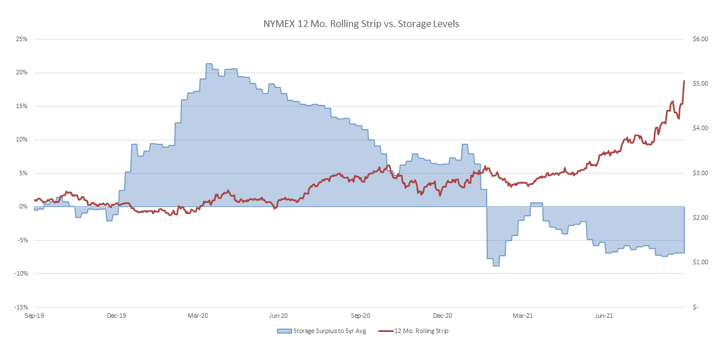
Figure 1: Percent of Lower 48 Natural Gas Storage Compared to the 5-year Average (gray) and NYMEX 12-month Forward Strip in $/MMbtu (red line)
KEITH: In addition, natural gas is in short supply in Europe. Europe acquires its gas through domestic production, LNG imports, and pipeline imports – including imports from Russia. The shortage is the result of a record hot summer, closing of production wells in Norway, declining imports from Russia and limited LNG cargos since early 2020. Europe is a world leader in renewables adoption as such and has phased out oil and coal. Now, there is an interest in reverting back to coal because gas prices have risen so high, but coal inventories have not been replenished. Renewables have helped offset coal and oil retirements but not enough to lower natural gas demand.
CHRIS: So, that’s the Supply piece of the puzzle, tell us about demand trends?
KEITH: Domestic U.S. demand for power generation hit an all-time record this past summer, due to hot weather, lower coal utilization, and because renewables underperformed. Specifically, the extreme drought that is plaguing the West resulted in lower hydro generation, less natural wind generation across the Midwest this past summer, and lower solar production as compared to historically higher levels. In addition, the industrial sector is booming, and economic activity is recovering. Growing markets such as petrochemical production and the oil refining process are very energy- and gas-intensive. That scenario has also driven increased demand.
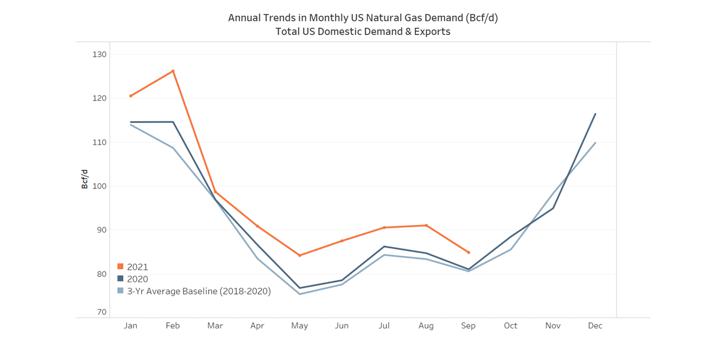
Figure 2: Total U.S. Domestic Demand Plus Exports
KEITH: Domestically speaking, exports represent the other piece of the puzzle. We net export 25 percent of what we use every day through LNG, through pipeline gas to Mexico, and a net trade deficit heading into Canada. Those exports are helping drive down – or helping to keep inventories below – that 5-year-average.
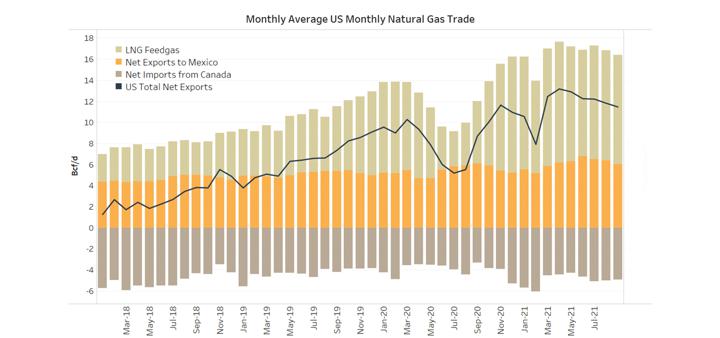
Figure 3: 3-Year Net Export Grown
Chris: Well, from my experience, the solution to high prices is high prices and the solution to low prices is low prices. What I mean is that high prices will change human behavior, attract more production, result in fuel-switching and arbitrage opportunities – as well as a host of other solutions. So, where do we go from here?
KEITH: We have already seen some production return to the market and increases in rig counts. Permits in Marcellus Shale are also on the rise. All of that is going to help push down price. We can expect additional pipeline capacity to come online, and that supplementary production-to-market scenario will help keep prices down. It is important to remember that there are more producers coming online due to higher future prices and lower barriers to entry. Even the markets are telling us that prices are not going to stay at these high levels. The forward prices are trading at a discount to winter 2021-22. An example of that would be a future price for calendar 2024 that is trading around $3.10 compared to a calendar 2022 trading at $4.50. In effect, the market is offering a 25 percent discount.
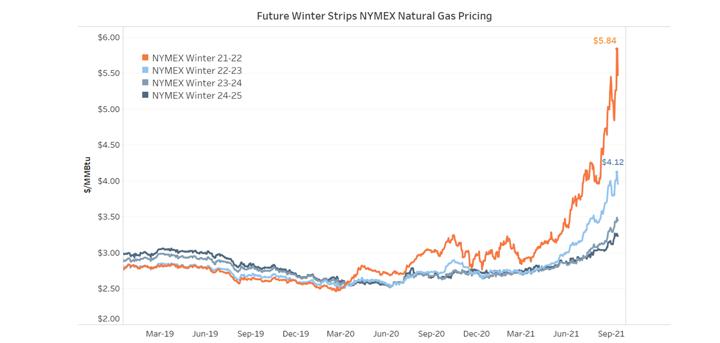
Figure 4: NYMEX Natural Gas Figures, Winter 2021-25 Strip Prices
Right now, the market is concerned with the upcoming winter. Headwinds are expected that will challenge near-term price reductions:
Fundamentally, there is a world shortage of coal and natural gas. Renewables have been intermittent, causing a reliance on natural gas. Demand is hitting all-time levels for electricity generation. Everybody is trying to fill storage at the same time. A significant amount of production increases will be needed to move that storage level needle. In addition, public energy production companies have become much more fiscally disciplined with their production expenditures and they are just not opening the spigot at any cost like they have done for the past 13 years.
Lastly, Europe is going to need to import a significant amount of gas from Russia. A new pipeline called Nord Stream 2 is coming online that will provide roughly half of what they need. This additional resource could help Europe’s storage levels recover as early as Q1 2022.
CHRIS: That is the commodity side. We still have to get the gas into New England. We have also seen an increase in BASIS, and it is a bigger percentage increase than for natural gas. What is driving BASIS prices up here in New England?
KEITH: ISO-New England has been warning us about this for a long, long time. Currently, a limited supply of natural gas pipeline infrastructure exists here in New England which means that the region is reliant on liquified natural gas at $25.00 per MMBtu and oil at $70.00/barrel. That price is equivalent to $11.00 per MMBtu, and there is no other alternative. In the winter, New England competes with Europe and Asia on price for shipments of LNG.
NYMEX & BASIS prices drive New England electricity prices. Over the course of the last year, wholesale electricity futures prices have moved from a decade low of $0.035/kWh to $0.063/kWh.
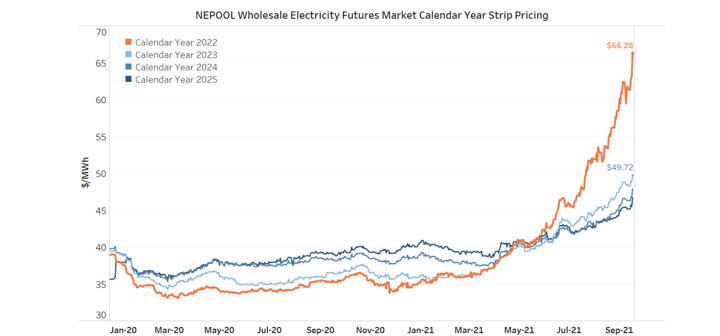
Figure 5: NEPOOL Wholesale Electricity Futures Yearly Strip Pricing
CHRIS: Right. Well, that was really interesting. It seems that one of the key take-aways is this: If you do have open positions for this winter, and you are relying on the spot market, it is going to be risky.
KEITH: Spot pricing always carries risk and many times, a reward. LNG prices and outdoor temperatures are the key drivers of spot prices. New England is going to continue to compete with Europe and Asia for shipments of LNG. If New England experiences a long stretch of sub-zero temperatures, spot prices are likely to rise above $35/MMBtu.
Another key take-away is the capital discipline that the production community is showing. Historically speaking, especially since the Marcellus Shale came online, producers drilled at any cost. They simply wanted to get those rigs running. Today, large corporations are focused on delivering dividends to stockholders. Producers need to open the spigot to drive down prices. The world is short on natural gas, and everyone is trying to fill up on storage at the same time. If New England has a warm winter, and demand is down, that could help speed up that process. If New England experiences a polar vortex this winter– or if the season is unusually cold – and if production does not pick up for some reason like we hope it does, high prices could be prolonged, and our collective situation could be worse in 2022. We could be looking at a similar picture next year at this time.
CHRIS: So, one option would be to put all of our eggs in the weather basket and hope that we have a warm winter. In your opinion, what are some other alternatives?
KEITH: Another approach, be proactive. Businesses should make sure they have no short positions and that they are covered this winter. Looking at futures prices, which are being offered at a discount to near term pricing, is also advisable. I recommend that companies use current market information to inform their budget and energy strategies. In addition, companies can start to look at selectively buying longer term deals. We are not reverting back to those decade-low prices anytime soon, and we are not going back to $2.00 gas. When you look at futures and calendar strips for 2023, 2024 and 2025, those are trading in the $3.00 range. Historically, $3.00 is not a bad price. Those are some strategies we are thinking about for our clients.
Now is a good time to also think about diversification. I think if you just hedge a portion today, and this is the low, and it goes higher – you’re going to be glad you did it. I hope it goes lower, and if it does – great! Now we come back and buy more at a lower price. Holding back and waiting for next spring could be a mistake.
Finally, an advised strategy is always the best strategy. It is important to remember that every strategy is going to be individual to each company because businesses utilize energy differently, have unique budgetary positions and needs, and different viewpoints on risk. Developing a customized strategy that begins with these fundamental approaches is what Competitive Energy Services does for clients. CES provides practical and accurate information and advice to help guide clients through difficult decisions. It is our role to lead clients through tumultuous times and we do so by understanding their needs, goals, and risk tolerance. We weigh that against the market trends and are careful about our recommendations.
Reach out to your CES Energy Services Advisor to discuss your company’s energy strategy, position, and options.
